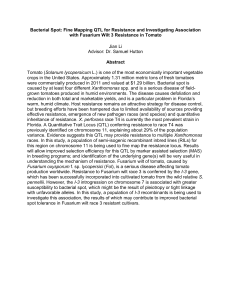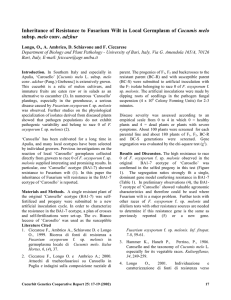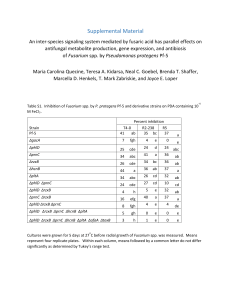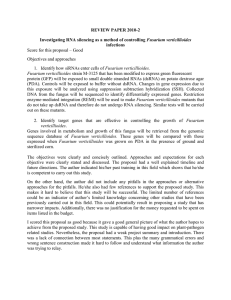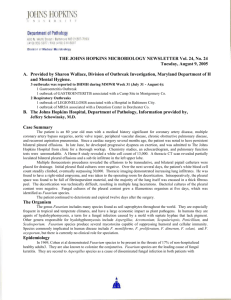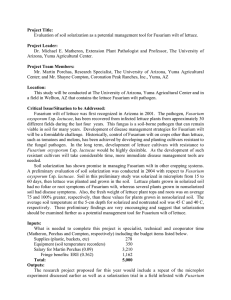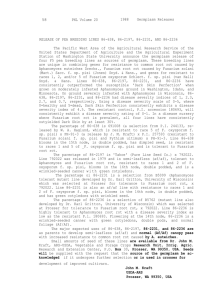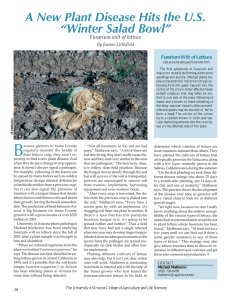Fusarium Wilt Resistance in Eight Identified Multiple Disease Resistant Genotypes
advertisement
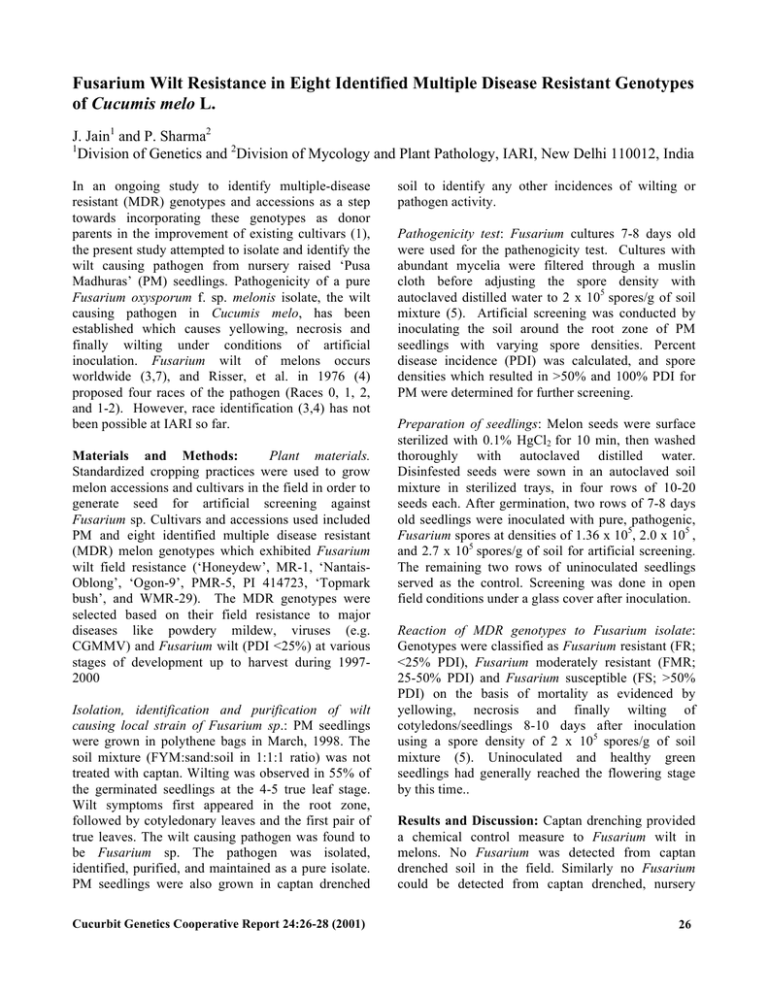
Fusarium Wilt Resistance in Eight Identified Multiple Disease Resistant Genotypes of Cucumis melo L. J. Jain1 and P. Sharma2 1 Division of Genetics and 2Division of Mycology and Plant Pathology, IARI, New Delhi 110012, India In an ongoing study to identify multiple-disease resistant (MDR) genotypes and accessions as a step towards incorporating these genotypes as donor parents in the improvement of existing cultivars (1), the present study attempted to isolate and identify the wilt causing pathogen from nursery raised ‘Pusa Madhuras’ (PM) seedlings. Pathogenicity of a pure Fusarium oxysporum f. sp. melonis isolate, the wilt causing pathogen in Cucumis melo, has been established which causes yellowing, necrosis and finally wilting under conditions of artificial inoculation. Fusarium wilt of melons occurs worldwide (3,7), and Risser, et al. in 1976 (4) proposed four races of the pathogen (Races 0, 1, 2, and 1-2). However, race identification (3,4) has not been possible at IARI so far. Materials and Methods: Plant materials. Standardized cropping practices were used to grow melon accessions and cultivars in the field in order to generate seed for artificial screening against Fusarium sp. Cultivars and accessions used included PM and eight identified multiple disease resistant (MDR) melon genotypes which exhibited Fusarium wilt field resistance (‘Honeydew’, MR-1, ‘NantaisOblong’, ‘Ogon-9’, PMR-5, PI 414723, ‘Topmark bush’, and WMR-29). The MDR genotypes were selected based on their field resistance to major diseases like powdery mildew, viruses (e.g. CGMMV) and Fusarium wilt (PDI <25%) at various stages of development up to harvest during 19972000 Isolation, identification and purification of wilt causing local strain of Fusarium sp.: PM seedlings were grown in polythene bags in March, 1998. The soil mixture (FYM:sand:soil in 1:1:1 ratio) was not treated with captan. Wilting was observed in 55% of the germinated seedlings at the 4-5 true leaf stage. Wilt symptoms first appeared in the root zone, followed by cotyledonary leaves and the first pair of true leaves. The wilt causing pathogen was found to be Fusarium sp. The pathogen was isolated, identified, purified, and maintained as a pure isolate. PM seedlings were also grown in captan drenched Cucurbit Genetics Cooperative Report 24:26-28 (2001) soil to identify any other incidences of wilting or pathogen activity. Pathogenicity test: Fusarium cultures 7-8 days old were used for the pathenogicity test. Cultures with abundant mycelia were filtered through a muslin cloth before adjusting the spore density with autoclaved distilled water to 2 x 105 spores/g of soil mixture (5). Artificial screening was conducted by inoculating the soil around the root zone of PM seedlings with varying spore densities. Percent disease incidence (PDI) was calculated, and spore densities which resulted in >50% and 100% PDI for PM were determined for further screening. Preparation of seedlings: Melon seeds were surface sterilized with 0.1% HgCl2 for 10 min, then washed thoroughly with autoclaved distilled water. Disinfested seeds were sown in an autoclaved soil mixture in sterilized trays, in four rows of 10-20 seeds each. After germination, two rows of 7-8 days old seedlings were inoculated with pure, pathogenic, Fusarium spores at densities of 1.36 x 105, 2.0 x 105 , and 2.7 x 105 spores/g of soil for artificial screening. The remaining two rows of uninoculated seedlings served as the control. Screening was done in open field conditions under a glass cover after inoculation. Reaction of MDR genotypes to Fusarium isolate: Genotypes were classified as Fusarium resistant (FR; <25% PDI), Fusarium moderately resistant (FMR; 25-50% PDI) and Fusarium susceptible (FS; >50% PDI) on the basis of mortality as evidenced by yellowing, necrosis and finally wilting of cotyledons/seedlings 8-10 days after inoculation using a spore density of 2 x 105 spores/g of soil mixture (5). Uninoculated and healthy green seedlings had generally reached the flowering stage by this time.. Results and Discussion: Captan drenching provided a chemical control measure to Fusarium wilt in melons. No Fusarium was detected from captan drenched soil in the field. Similarly no Fusarium could be detected from captan drenched, nursery 26 Table 1: Effect of spore concentration on Fusarium pathogenicity for cv. Pusa Madhuras (PM) seedlings. ____________________________________________________________ Spores density PDIz (spores/gm of soil mixture) ____________________________________________________________ 0 (control) 5 1.36 x 105 50 2.0 x 105 73 ± 9 2.7 x 105 100 ____________________________________________________________ z PDI: Percent disease incidence Table 2. Artificial screening of eight identified resistant accessions to Fusarium wilt by soil inoculation method. _________________________________________________________________________ Accessions Percent disease incidence (PDI) Class Control (no Fusarium)z Inoculated conditionsy _________________________________________________________________________ Honeydew 0.0* 23.61 ± 1.96 FR MR-1 0.0 16.25 ± 5.30 FR Nantais-Oblong 0.0 0.0 FR Ogon-9 0.0 17.14 ± 4.04 FR PMR-5 0.0 0.0 FR P1-4 14723 0.0 5.55 ± 6.03 FR Topmark Bush 0.0 0.0 FR WMR-29 0.0 6.25 ± 6.73 FR _________________________________________________________________________ z Control: autoclaved soil with no Fusarium inoculation. y Autoclaved soil with Fusarium inoculation of spores density as 1.36 x 105 spores/g of soil mixture. x ‘Honeydew’ exhibited some cotyledonary shriveling. Cucurbit Genetics Cooperative Report 24:26-28 (2001) 27 raised PM seedlings and plants, although Pythium wilting was observed in 3% of the PM plants, which wilted at 2-4 true leaf stage. The pure F. oxysporum isolate was found to be highly pathogenic, and could induce 73% PDI with a spore density 2 x 105 spores/g of soil mixture on PM under artificial inoculation conditions. No Fusarium incidence was observed in 95% of the uninoculated control PM seedlings. A spore density of 1.36 x 105 spores/g of soil mixture (which caused 50% PDI in PM) was used for artificial screening of the 8 MDR genotypes. PDI was <25% for all 8 genotypes (Table 2), and they were therefore classified as Fusarium resistant genotypes by the artificial screening method. Previously, Zuniga and Zitter (7) had confirmed MR-I as FR based on artificial screening after establishing the pathogenicity of their isolate Similar studies have identified Fusarium wilt as a significant factor in melon production (2,6,7). The 8 identified FR genotypes of C. melo can be incorporated as donor parents in the resistance breeding program of existing cultivars. In addition, molecular marker techniques may be useful in the future to utilize the gene(s) that control resistance to Fusarium wilt. Cucurbit Genetics Cooperative Report 24:26-28 (2001) Literature cited 1. Jain, J. and V.K. Verma. 2000. Characterization of identified disease resistant lines in melon, Cucumis melo L. Cucurbit Genetics Coop. 23:3740. 2. Martyn, R.D., L.W. Barnes and J. Amador. 1987. Fusarium wilt (F. oxysporum f.sp melonis Race 0) of muskmelons in Texas. Plant Disease 71:469 (Abstr). 3. Mohamed, Y.F., G.A. DaFalla and S.K. Omara. 1994. Races of Fusarium oxysporum f.sp. melonis causing wilt of melons in central Sudan. Cucurbit Genetics Coop. 17:66-68. 4. Risser, G., Z. Banihashemi and D.W. Davis 1976. A proposed nomnclature of Fusarium oxysporum f.sp. melonis races and resistance genes in Cucumis melo. Phytopathology 66:1105-1106. 5. Thomas, P. 1989. Studies on Fusarium wilt resistance in muskmelon (Cucumis melo L.) Ph.D. Thesis (Hort.) of IARI, New Delhi, India. 6. Zuniga, T.L. and T.A. Zitter 1993. A new race of Fusarium Oxysporum f.sp. melonis causing wilt of muskmelon in New York. Phytopathology. 83:1344 (Abstr). 7. Zuniga, T.L. and T.A. Zitter 1995. Field screening of melon varieties and lines for multiple race resistance to Fusarium oxysporum f.sp melonis. Cucurbit Genetics Coop. 18:43. 28
